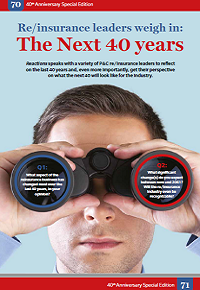
Peter Hearn, CEO of Guy Carpenter, spoke to Reactions reflecting on the last 40 years and providing his perspective on what the next 40 will look like for the industry. The following was originally published in Reactions.
Q1: What aspect of the reinsurance business has changed most over the last 40 years, in your opinion?
At Guy Carpenter and Marsh & McLennan, our purpose is to “make a difference in the moments that matter.” If we reflect on the most challenging situations and the defining events of the last 40 years, the re/insurance industry should be proud of its ability to rise to the occasion and “make a difference.” The asbestos and liability crisis in the 1980s, Hurricane Andrew in 1992, the World Trade Center attacks in 2001, and the global financial crisis in 2008 all provide examples of the industry’s ability to evolve and improve itself to meet the continuously changing nature of risk.
The embrace of data, analytics, modelling, and actuarial science has proven to be dramatically beneficial. An improved understanding of risk has attracted vast new sources of capital to the space, and enhanced the financial resiliency of re/insurers that has proven itself time and time again.
At the beginning of this century, in the wake of the tragic events of September 11, 2001, we gained a deeper understanding of the impact of systemic risk. We also learned the critical importance of supporting new products and solution innovations that can ensure businesses around the world are protected from new systemic risks.
The industry’s focus on tail risk and prudent financial management was borne out in the financial crisis in 2008, and again during the global pandemic to start this decade. The industry continues to adopt new risk evaluation tools, embed more rigorous risk governance approaches, and expand and utilize broader forms of capital to help distribute risk.
In all of these cases over the decades, the industry rose to the challenges and came out stronger and better prepared to serve our customers and the global community.
Q2: What significant change(s) do you expect between now and 2061? Will the re/insurance industry even be recognizable?
Just as we saw over the past 40 years, the next 40 years will see many new risks and hurdles, and I believe the re/ insurance industry will most certainly rise to the challenge. As the types of risk expand from those that are physical to those that are intangible, the re/insurance industry will need to respond by providing new and essential financial protection and risk mitigation services.
We will also need to recognize that certain risks are beyond the capital capabilities of the re/insurance industry alone. I see the industry embracing climate change and becoming an active voice in establishing sustainable public- private partnerships that ensure the resilience of our global communities.
As in the current times, innovation will be critical to provide products that comprehensively meet the needs of the end consumer, both individual and corporate. In addition, the re/ insurance industry needs to modify and enhance distribution to reduce frictional costs for the customer, as well as upgrade the overall customer experience. Therefore, I foresee an increase in the number of hybrid solutions for complex risks, including prevention consulting, protection coverage and financing, which may encourage the banking and insurance sectors to come closer together. The structure of the industry will change and segments within the industry are likely to become more embedded within the broader financial community, or distributed across other service providers.

Download the Full Report
Reactions speaks with a variety of P&C re/insurance leaders to reflect on the last 40 years and, even more importantly, get their perspective on what the next 40 will look like for the industry.